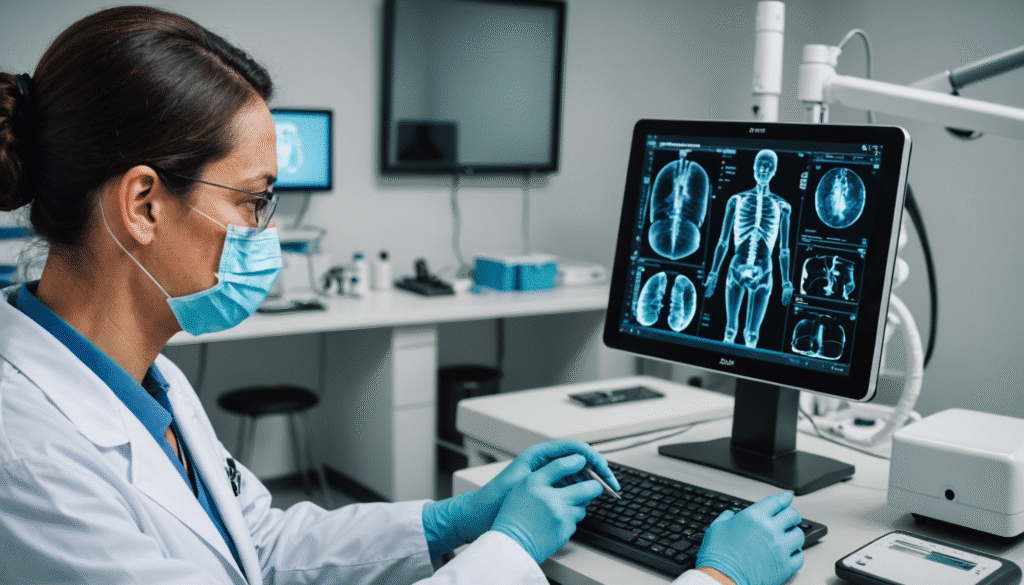There robotic surgery in urology appears to be a significant advance in the medical field, offering cutting-edge techniques to improve the precision of interventions. With the recent installation of surgical robots and the launch of major training campaigns, the first results highlight a rate of successful operations. These promising results pave the way for an increase in robotization and emphasize the importance of interdisciplinary collaboration in surgical procedures. The outlook indicates a dynamic future for this technology, aimed at optimizing surgical procedures while reducing traditional associated risks.

There robotic surgery represents a major advance in the medical field, particularly in urology. Since the introduction of robotic systems, such as the robot Da Vinci, surgical methods have evolved, allowing less invasive interventions, and consequently, better comfort for patients. In 2023, the results of the installation of these technologies already show convincing results. Nearly 90 operations were carried out, demonstrating the success of this technological transition.
There surgical robotics in urology has the main objectives of optimizing the quality of surgical procedures and reducing associated risks. In terms of ablation, in particular, the results are more promising than with traditional techniques, thanks to increased precision in the handling of the instruments. This technology is particularly effective for procedures such as prostate ablation.
Studies evaluate the medico-economic impact of integrating robots into the operating circuit. A report mentions that their use reduces significantly reduced postoperative pain and bleeding, which results in a faster return to normal for the patient. Beyond the immediate benefits, it is important to look at the long-term implications of robotic surgery on quality of life and overall costs of care.
Through recent results, an observation emerges: the robotic surgery can significantly improve the patient experience. The precision of the robot’s movements, possible thanks to remote control operated by the surgeon, minimizes tissue trauma. Patients thus benefit from shorter hospitalizations and a reduced risk of infections. These elements are crucial in the care pathway, particularly in urological procedures where rapid recovery is often necessary.
Beyond the technical aspects, the human aspect should not be neglected. Medical teams, often made up of surgeons, specialized nurses and anesthesiologists, must be trained in advance in the use of new technologies. The results of the investigation into competence in robotic surgery reveals a need for regular updating of training protocols. Continuing training and real-world case simulations are essential to ensure a favorable learning curve. This teamwork is essential to make the most of the capabilities offered by this technology.
The prospects for the robotics in surgery are promising. Advances in robotic technology continue to grow, and the current trend shows an increase in expansion projects into other surgical specialties. New applications planned for next year include interventions in the field of gastrointestinal surgery as well as in the gynecological sector. This development could make it possible to double, or even triple, the volume of interventions carried out with robots within healthcare establishments.
In addition, with the increasing digitalization of clinical data, robotics could integrate artificial intelligence tools, thus allowing better preparation and personalization of interventions. Research initiatives are multiplying to evaluate the effectiveness of new surgical assistance solutions. These technological innovations plan to go beyond current limits by making interventions even more precise and less intrusive. Another area of development concerns post-operative support using remote monitoring devices.
Technological issues are also crucial. There robotic surgery must continue to adapt to the growing needs of patients. Real-time data collection performed by robotic systems could provide a better understanding of postoperative outcomes. Furthermore, a second surgical robot, recently acquired by the Poitiers University Hospital, demonstrates this desire for continuous improvement. The expected results include a reduction in operating times and an increase in patient care capacity. This development contributes to expanding the availability of care in various hospital structures.
It is therefore fundamental to begin thinking about the future of robotic surgery in urology. Health stakeholders must question the benefits of increasing investment in robotic technologies. In addition to an improvement in the quality of care, this investment responds to a growing demand from patients wishing to benefit from less traumatic and unmanageable interventions in complete safety.
In this context, a policy of continuous evaluation is necessary. Practices must be constantly updated and adapted to practice. Regular evaluation of results, in line with technological developments, will ensure transparency and trust within medical teams and patients. In addition, it is possible to draw inspiration from models developed internationally, where major players in the medtech invest massively in R&D to continue to optimize their devices.
As part of this process, it is important to remember that patient safety must remain the priority. Thus, robotic systems must be designed and continuously improved with a concern for ethics and traceability. Collaborative projects between public institutions and private companies are increasingly cited as examples of successful innovation in the medical sector.
Finally, it is imperative to consider the robotic surgery as a lever to strengthen operational capacities in the health sector. Optimizing procedures using robotic tools could also contribute to better management of hospital resources. The increased availability of robots would allow a redistribution of tasks allowing surgeons to direct their efforts towards more complex cases while maintaining a high level of efficiency using robots for routine interventions.
In short, the robotic surgery in urology is at a turning point in its evolution. The assessments carried out to date highlight undeniable successes, supported by encouraging future prospects. However, it is essential to remain vigilant and ensure that the implementation of these technologies continues to be done within an ethical and responsible framework, while keeping an eye on future innovations that could redefine the standards of excellence in matters of urological care.

Robotic surgery in urology represents a significant advance in the medical field, making it possible to improve the quality of surgical interventions while reducing post-operative complications. The results of the first operations carried out until the end of 2023 reveal promising results, in particular thanks to the precision of the robotic instruments, thus making it possible to broaden the scope of application of this technology. In this article, we will discuss the successes observed, the challenges encountered, as well as the future prospects of this innovative discipline.
Assessment of the interventions carried out
Since the installation of the surgical robot in 2023, nearly 90 interventions have been carried out, mainly in the field of urology. Data collected during this period indicates a notable improvement in factors such as post-operative pain and bleeding. This is largely due to the minimally invasive surgical techniques that the robot enables, facilitating faster patient recovery and promoting a better quality of life after surgery.
Medical-economic impact
The medico-economic evaluation of robotic surgery in urology is essential to measure its long-term impact. The costs associated with the use of surgical robots are often offset by reduced hospital stays and post-operative complications. Investment in robotic technology could therefore be justified in terms of clinical effectiveness and cost savings, thus affirming the viability of this approach for the healthcare system.
Training and skills of surgical teams
The success of robotic surgery relies largely on the continuing education of surgeons. It is imperative to integrate training programs specific to this technique into the basic medical curriculum. Specialists must acquire strong technical skills in order to properly use robotic instruments and minimize the learning curve. The implementation of appropriate and regular training is crucial to guarantee the excellence of the surgical interventions performed.
Future outlook
The outlook for robotic surgery in urology is very encouraging. With the expected increase in robotic activity, it is anticipated that teamwork among healthcare professionals will strengthen, thus promoting a collaborative framework conducive to innovation. In addition, decision support solutions assisted by artificial intelligence could emerge, further improving the precision of interventions.
Technological challenges and innovations
Robotization in surgery presents technological challenges that must be overcome. Innovations in robotic equipment must continue, in order to improve the maneuverability and versatility of current systems. New surgical techniques could emerge, making even more complex interventions possible with increased safety for patients.
In summary, robotic surgery in urology has demonstrated its potential to transform surgical practices, both by improving clinical outcomes and optimizing cost management. However, to reach its full potential, it requires a continued commitment to training, technological innovation and interdisciplinary collaboration.









